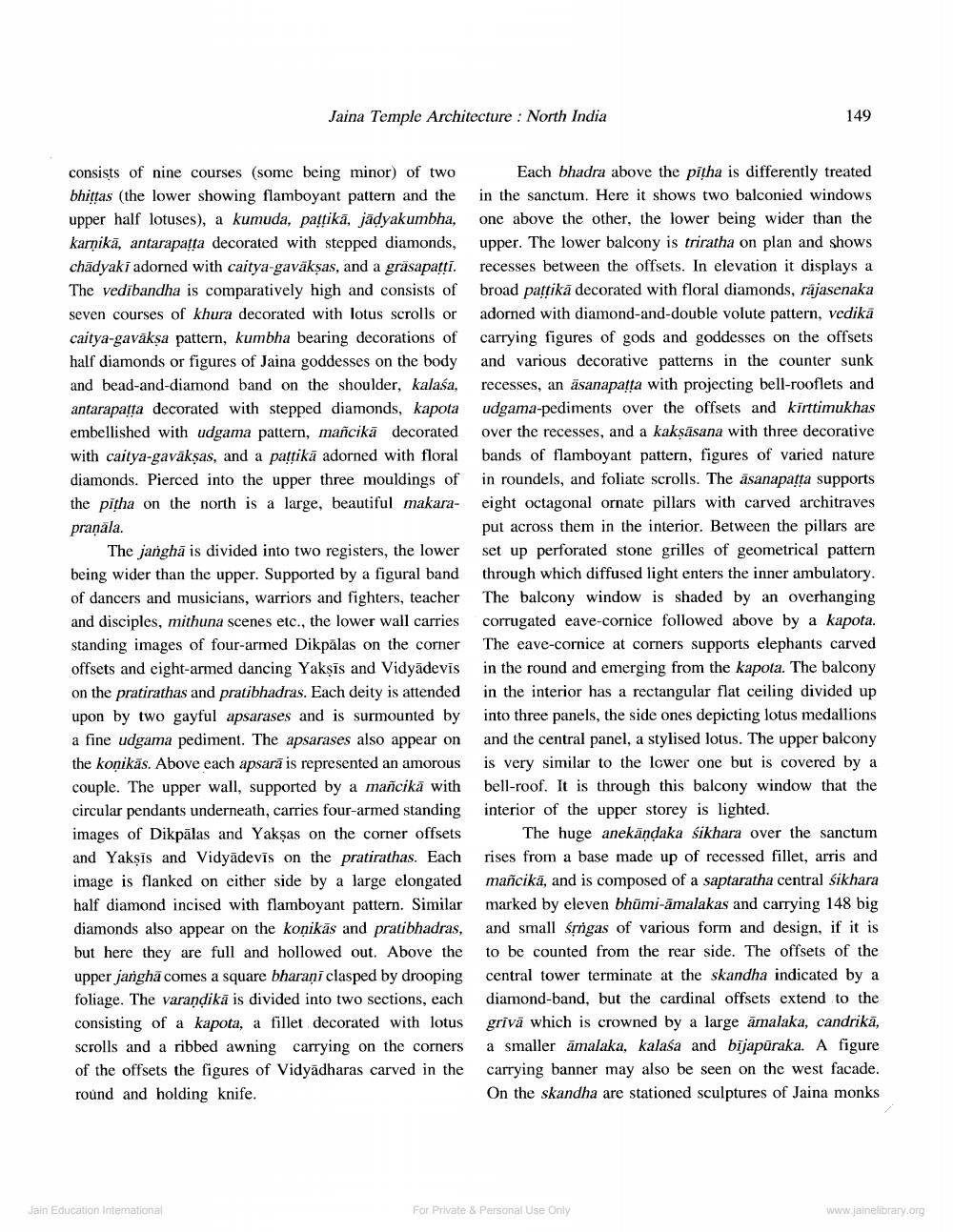________________
Jaina Temple Architecture : North India
149
consists of nine courses (some being minor) of two bhittas (the lower showing flamboyant pattern and the upper half lotuses), a kumuda, pattikä, jadyakumbha, karņikā, antarapatta decorated with stepped diamonds, chadyaki adorned with caitya-gavākşas, and a grāsapatti. The vedībandha is comparatively high and consists of seven courses of khura decorated with lotus scrolls or caitya-gavākṣa pattern, kumbha bearing decorations of half diamonds or figures of Jaina goddesses on the body and bead-and-diamond band on the shoulder, kalasa, antarapatta decorated with stepped diamonds, kapota embellished with udgama pattern, mañcikā decorated with caitya-gaväksas, and a pattikä adorned with floral diamonds. Pierced into the upper three mouldings of the pitha on the north is a large, beautiful makara- praņāla.
The janghā is divided into two registers, the lower being wider than the upper. Supported by a figural band of dancers and musicians, warriors and fighters, teacher and disciples, mithuna scenes etc., the lower wall carries standing images of four-armed Dikpalas on the corner offsets and eight-armed dancing Yakṣīs and Vidyādevīs on the pratirathas and pratibhadras. Each deity is attended upon by two gayful apsarases and is surmounted by a fine udgama pediment. The apsarases also appear on the koņikās. Above each apsarā is represented an amorous couple. The upper wall, supported by a mañcikä with circular pendants underneath, carries four-armed standing images of Dikpālas and Yaksas on the corner offsets and Yakṣīs and Vidyādevis on the pratirathas. Each image is flanked on either side by a large elongated half diamond incised with flamboyant pattern. Similar diamonds also appear on the koņikās and pratibhadras, but here they are full and hollowed out. Above the upper janghā comes a square bharaṇi clasped by drooping foliage. The varandikā is divided into two sections, each consisting of a kapota, a fillet decorated with lotus scrolls and a ribbed awning carrying on the corners of the offsets the figures of Vidyādharas carved in the round and holding knife.
Each bhadra above the pitha is differently treated in the sanctum. Here it shows two balconied windows one above the other, the lower being wider than the upper. The lower balcony is triratha on plan and shows recesses between the offsets. In elevation it displays a broad pattikā decorated with floral diamonds, rajasenaka adorned with diamond-and-double volute pattern, vedikā carrying figures of gods and goddesses on the offsets and various decorative patterns in the counter sunk recesses, an asanapatta with projecting bell-rooflets and udgama-pediments over the offsets and kirttimukhas over the recesses, and a kakşāsana with three decorative bands of flamboyant pattern, figures of varied nature in roundels, and foliate scrolls. The asanapatta supports eight octagonal ornate pillars with carved architraves put across them in the interior. Between the pillars are set up perforated stone grilles of geometrical pattern through which diffused light enters the inner ambulatory. The balcony window is shaded by an overhanging corrugated eave-cornice followed above by a kapota. The eave-cornice at corners supports elephants carved in the round and emerging from the kapota. The balcony in the interior has a rectangular flat ceiling divided up into three panels, the side ones depicting lotus medallions and the central panel, a stylised lotus. The upper balcony is very similar to the lower one but is covered by a bell-roof. It is through this balcony window that the interior of the upper storey is lighted.
The huge anekāndaka sikhara over the sanctum rises from a base made up of recessed fillet, arris and mañcikā, and is composed of a saptaratha central śikhara marked by eleven bhūmi-āmalakas and carrying 148 big and small śrngas of various form and design, if it is to be counted from the rear side. The offsets of the central tower terminate at the skandha indicated by a diamond-band, but the cardinal offsets extend to the grīvā which is crowned by a large āmalaka, candrikā, a smaller amalaka, kalaśa and bijapūraka. A figure carrying banner may also be seen on the west facade. On the skandha are stationed sculptures of Jaina monks
Jain Education Intemational
For Private & Personal Use Only
www.jainelibrary.org




